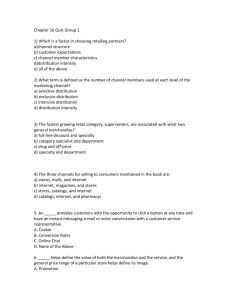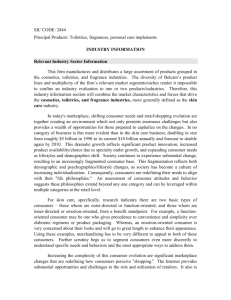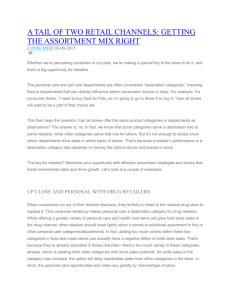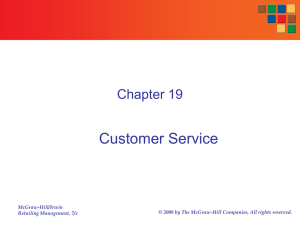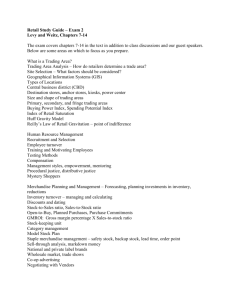Group 3 – Team Red Raider
advertisement
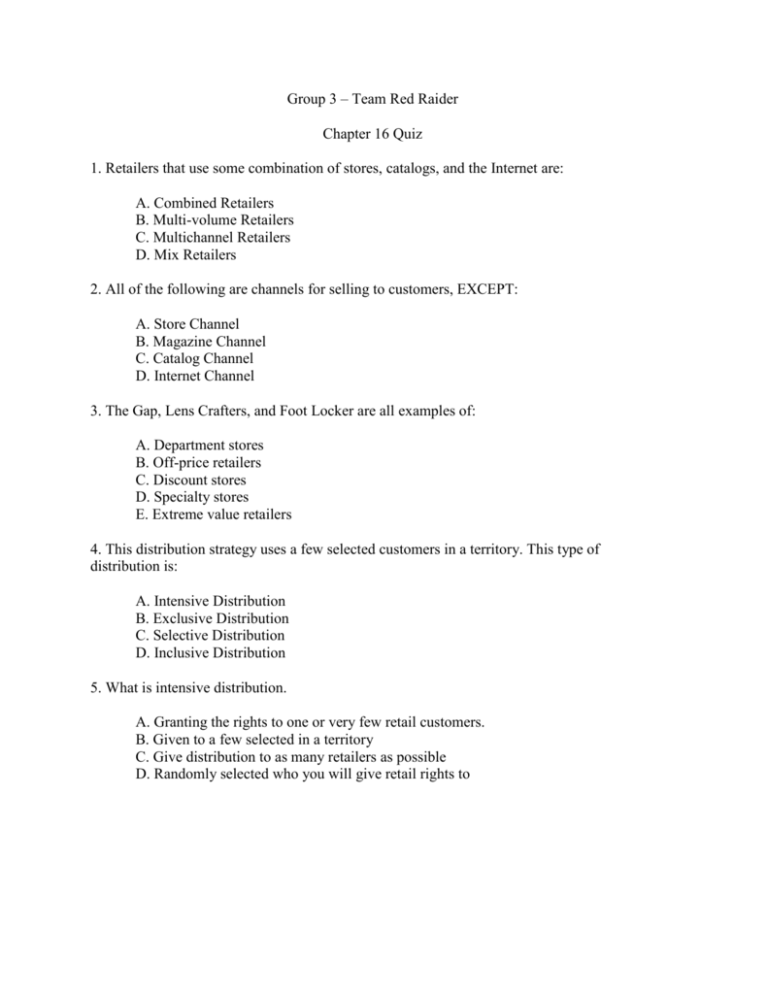
Group 3 – Team Red Raider Chapter 16 Quiz 1. Retailers that use some combination of stores, catalogs, and the Internet are: A. Combined Retailers B. Multi-volume Retailers C. Multichannel Retailers D. Mix Retailers 2. All of the following are channels for selling to customers, EXCEPT: A. Store Channel B. Magazine Channel C. Catalog Channel D. Internet Channel 3. The Gap, Lens Crafters, and Foot Locker are all examples of: A. Department stores B. Off-price retailers C. Discount stores D. Specialty stores E. Extreme value retailers 4. This distribution strategy uses a few selected customers in a territory. This type of distribution is: A. Intensive Distribution B. Exclusive Distribution C. Selective Distribution D. Inclusive Distribution 5. What is intensive distribution. A. Granting the rights to one or very few retail customers. B. Given to a few selected in a territory C. Give distribution to as many retailers as possible D. Randomly selected who you will give retail rights to 6. _________________ uses a few selected customers in a territory? A. Selective distribution B. Off-price retailers C. Specialty stores D. Warehouse clubs 7. An ____________________ strategy is designed to get products into as many outlets as possible. A. Intensive distribution B. Extreme value retailers C. Full-line discount stores D. Drugstores 8. What type of distribution uses few selected customers in a territory? A. Intensive B. Selective C. Exclusive D. Targeted 9. Shopping over the Internet offers the customer A. a broader selection B. more information to evaluate merchandise C. personalization D. merchandise with “touch-and-feel” attributes E. all of the above 10. Irregulars are A. customers that do not buy normal products. B. particles of antimatter. C. merchandise that has minor mistakes in construction. D. people unable to work. 1. 2. 3. 4. 5. 6. 7. 8. C B D C C A A B 9. E 10. C Chapter 16 Quiz 1. What is a specialty store? A. Retailers that organize their stores into distinct departments B. Retailers that offer a broad variety of merchandise, limited service and low prices C. Stores who concentrate on a limited number of complementary merchandise categories and provide high level of service D. Stores that concentrate on pharmaceuticals, health and personal grooming merchandise 2. The goals for a retailer do not include: A. Overcoming the limitations of their existing format B. Expanding their market presence C. Increasing share of wallet D. Expanding facilities 3. Which of these is not a benefit of internet shopping? A. Broader selection B. Cash and credit C. More information D. Personalization 4. Which of the following is not a factor for establishing a relationship with retailers? A. Identifying types of retailers B. Facilitating retail strategy C. Managing a multichannel strategy D. None of the above 5. __________, also known as big box retailers or category killers, are discount stores that offer a narrow but deep assortment of merchandise. A. Full line discount stores B. Department stores C. Specialty stores D. Category specialist 6. Which of the following is an example of a retailer that consists of a limited variety of goods and can be found at good locations? A. Supermarket B. Supercenter C. Warehouse club D. Convenience store 7. Which of the following is not one of the benefits provided by shopping in-store? A. Personal service B. Entertainment C. Safety D. Browsing 8. What are small, full-line discount stores that offer a limited merchandise assortment at very low prices called? A. Off-price retailers B. Extreme value retailers C. Outlet stores D. Full line discount stores 9. Which of the following is a level of distribution intensity commonly used by firms? A. Exclusive B. Immediate C. Convenient D. Specialty 10. Which of these is not considered a general merchandise retailer? A. Category specialist B. Department C. Convenience D. Drug Answers: 1. 2. 3. 4. 5. 6. 7. 8. 9. 10. C D B D D D C B A C




